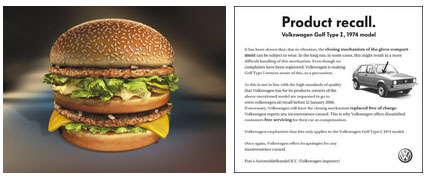Product recalls are every manufacturer’s worst nightmare. Recalls have a negative impact on your brand; inflate your costs to enormous proportions and you might even end up with a Facebook hate page or two. Despite all of this, there has been a big rise in recalls because of strict regulations, consumers that speak up and increasingly complex products.
Caution, explosive brand!
A product doesn’t just get recalled for any reason, mostly a serious or even dangerous product error is at play. Philips once had to recall thousands of LCD TV’s after the electronics manufacturer had found out their TV’s might electrocute people. Competitor Sony had to process a similar shock when they were forced to pay almost 300 million euros to recall certain ‘explosive’ laptop batteries. Toyota recalled 1.35 million cars when they found out the belt system was flammable when a collision occurred. That last case is an example of something that can really damage a brand, because the incident is related to the brand’s core values: safety and reliability. Another example of this is Olvarit, a brand that aims to make healthy and natural baby food, but was faced with jars that had been contaminated by cleaning products.

Contaminated brands
Negative publicity can have an impact on brand level. In that case, only the one brand involved suffers a few blows, while its competition might benefit. Pepsi Cola got a boost thanks to a Coca-Cola scandal involving a number of students who got sick after drinking a bad batch of Coke. But a brand crisis can also have ramifications that spread across the entire market. When a few crash tests proved one Nissan pick-up truck to be life-threateningly dangerous, the negative publicity cast a shadow over the entire pick-up truck industry, making people believe Toyota, Isuzu and Mazda pick-up trucks were dangerous as well.

Emergency warning
An incident can escalate into a crisis that has strategic disadvantages for the brand or the entire market. You can’t escape from negative publicity, but you can limit the amount of (brand) damage. Rumours can be avoided by supplying sufficient and extensive information; even if that info is mostly negative. ‘The first 24 hours’ are crucial to inform the general public as well as the product’s users when a product recall goes into effect.
Brand gossip
Procter&Gamble sponsors Satan’s Church and Marlboro sends money to the Ku Klux Klan. Drinking Schweppes causes impotence, washing your hair with Wash&Go will make you go bald and don’t be surprised when you find a piece of worm in your Big Mac. These are all examples of negative statements that are based on pure fiction. Sometimes this kind of gossip gets out of hand, forcing producers to pull out all the stops to refute the made-up story. Some brands find the humour in all of this, like Volkswagen when they put out a fake product recall. They issued an ad calling all owners of a ’74 Golf I to bring in their cars due to ‘light wear and tear of the glove compartment mechanism’. Obviously this was a joke, Volkswagen wanted to highlight the quality of their cars. In the end, all owners of a ’74 Golf I who reported their vehicle got their car serviced for free.





